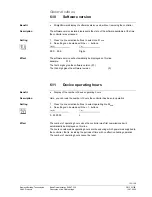
143/166
Siemens Building Technologies
Basic Documentation RVA47.320
CE1P2379E
HVAC Products
Functions with no settings
15.07.2002
7.9 Frost
protection
•
Ensures that the boiler and d.h.w. temperature will not fall below a certain level
In addition to the frost protection modes described here, frost protection for the building
and frost protection for the plant, whose parameters can be set, are also active. For
details, refer to the description given on lines 15 and 33
OEM
.
7.9.1
For the boiler
The frost protection function for the boilers is integrated in the BMUs. For detailed
information, refer to the technical documentation of the product used.
For details, refer to the documentation of the relevant product.
7.9.2
For the d.h.w.
Frost protection for the d.h.w. prevents freeze-ups of the d.h.w. storage tank that is
connected directly to the RVA47.320. Whenever the d.h.w. temperature drops
excessively, forced charging will be initiated.
If... then...
the actual value of the d.h.w. temperature falls below 5
°C...
(TBWx < 5 °C)
... the frost protection
function for the d.h.w.
becomes
active
the actual value of the d.h.w. temperature exceeds 5 °C
by more than one d.h.w. switching differential (line
41
OEM
)...
(TBWx > 5 °C + SDBW)
... the frost protection
function for d.h.w. will be
terminated
•
The frost protection setpoint for the d.h.w. is factory-set at 5 °C and cannot be
changed
•
Pump overrun will be activated when d.h.w. heating is terminated.
•
The frost protection function only acts on a d.h.w. storage tank connected directly
to the RVA47.320. In the case of plant types with d.h.w. heating via BMU, this
function must be provided by the BMU.
•
The frost protection function is only active when using a temperature sensor. If the
d.h.w. is heated with the help of a control thermostat, no frost protection function is
possible because there is no actual value of the storage tank temperature.
Benefit
Note
Description
Process
Notes
Important
















































